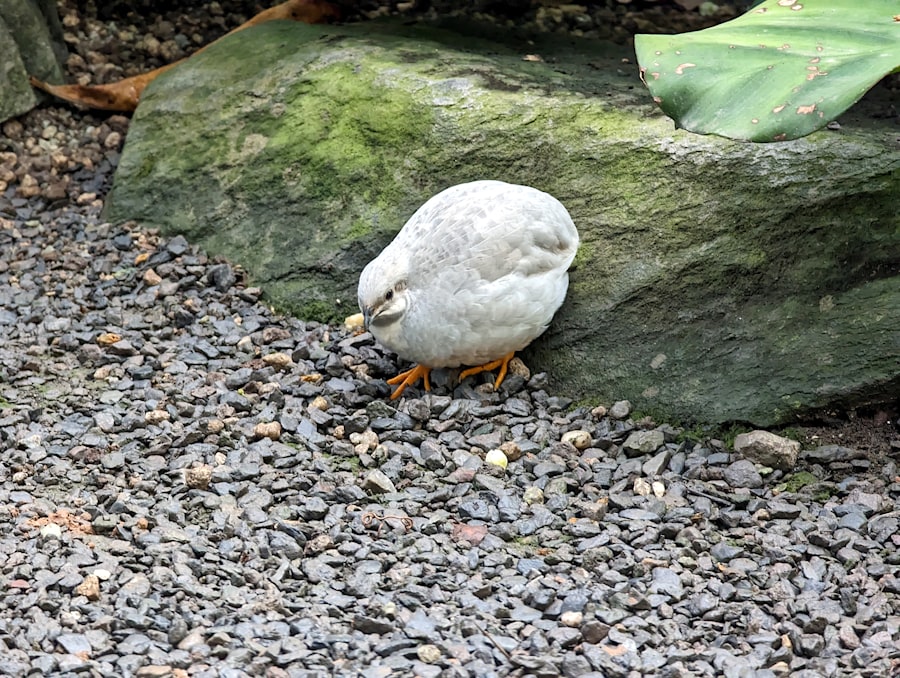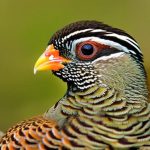When it comes to housing your coturnix quail, there are a few important factors to consider. First and foremost, you’ll want to make sure that the housing you choose provides enough space for your quail to move around comfortably. A good rule of thumb is to allow for at least 1 square foot of space per bird. Additionally, it’s important to provide a secure enclosure that will protect your quail from predators and the elements. This can be achieved with a sturdy wire mesh or a solid wooden structure.
Another important consideration when choosing housing for your coturnix quail is ventilation. Quail are sensitive to high levels of ammonia and other airborne pollutants, so it’s crucial to ensure that their living space is well-ventilated. This can be achieved by incorporating windows, vents, or other openings into the design of the enclosure. Additionally, it’s important to provide a clean and dry living environment for your quail. This means regularly cleaning out their bedding and ensuring that their living space is free from moisture and mold.
Key Takeaways
- Choose a housing that provides enough space for your coturnix quail to move around and has proper ventilation
- Provide a balanced diet with a mix of commercial quail feed, fresh greens, and occasional treats
- Maintain a consistent lighting schedule and keep the temperature between 60-75°F for optimal health
- Keep the housing clean and provide regular dust baths for hygiene
- Handle your coturnix quail gently and spend time socializing them to reduce stress and aggression
- Create a separate breeding area and ensure proper incubation conditions for successful hatching
- Monitor for signs of common issues such as respiratory infections and provide prompt treatment as needed
Providing the proper diet and nutrition for your coturnix quail
Proper nutrition is essential for the health and well-being of your coturnix quail. In the wild, quail are omnivorous and will eat a variety of seeds, insects, and vegetation. When kept in captivity, it’s important to provide a balanced diet that mimics their natural food sources. This can be achieved by offering a high-quality game bird feed that is specifically formulated for quail. Additionally, you can supplement their diet with fresh fruits and vegetables, as well as mealworms or other insects.
It’s important to ensure that your quail have access to clean, fresh water at all times. Quail are prone to dehydration, so it’s crucial to regularly check their water supply and ensure that it is free from contaminants. Additionally, it’s important to monitor their food intake and adjust their diet as needed. For example, during the breeding season, female quail may require additional calcium to support egg production. By providing a balanced and nutritious diet, you can help ensure that your coturnix quail remain healthy and productive.
Understanding the importance of proper lighting and temperature for coturnix quail
Proper lighting and temperature are crucial factors in ensuring the health and well-being of your coturnix quail. Quail are sensitive to changes in light and temperature, so it’s important to provide a consistent environment for them. When it comes to lighting, quail require a natural day-night cycle to maintain their circadian rhythms. This can be achieved by providing 14-16 hours of light per day using artificial lighting. It’s important to provide a period of darkness for your quail to rest and recharge.
In addition to lighting, temperature also plays a critical role in the health of your coturnix quail. Quail are sensitive to extreme temperatures, so it’s important to provide a comfortable and consistent environment for them. The ideal temperature for adult quail is between 60-75 degrees Fahrenheit, while chicks require slightly higher temperatures of around 95 degrees Fahrenheit during their first week of life. This can be achieved by using heat lamps or other heating sources to maintain a stable temperature within their living space.
Maintaining the health and hygiene of your coturnix quail
Maintaining the health and hygiene of your coturnix quail is essential for preventing disease and ensuring their overall well-being. One of the most important aspects of maintaining their health is keeping their living space clean and free from contaminants. This means regularly cleaning out their bedding, removing droppings, and ensuring that their living environment is free from moisture and mold. Additionally, it’s important to provide proper ventilation to prevent the buildup of ammonia and other airborne pollutants.
In addition to maintaining a clean living environment, it’s important to monitor the health of your quail on a regular basis. This includes checking for signs of illness or injury, monitoring their food and water intake, and observing their behavior. If you notice any changes in their health or behavior, it’s important to take action immediately by consulting with a veterinarian who specializes in avian care. By staying proactive and attentive to the health and hygiene of your coturnix quail, you can help ensure that they remain healthy and thriving.
Handling and socializing your coturnix quail
When it comes to handling and socializing your coturnix quail, it’s important to approach them with care and patience. Quail are naturally skittish birds and may be easily startled by sudden movements or loud noises. It’s important to approach them calmly and gently, allowing them to become accustomed to your presence over time. By spending time near their enclosure and speaking softly to them, you can help them become more comfortable with human interaction.
It’s also important to provide opportunities for socialization within their flock. Quail are social birds that thrive in the company of others, so it’s important to provide them with plenty of space to move around and interact with one another. Additionally, providing enrichment activities such as dust baths or foraging opportunities can help keep your quail mentally stimulated and engaged. By providing a positive and enriching environment for your coturnix quail, you can help them develop into healthy and well-adjusted birds.
Breeding and incubating coturnix quail eggs

Breeding and incubating coturnix quail eggs can be a rewarding experience for poultry enthusiasts. When it comes to breeding, it’s important to provide a suitable environment that encourages natural mating behaviors. This can be achieved by providing a balanced ratio of males to females within the flock, as well as plenty of space for courtship displays and mating rituals. Additionally, it’s important to monitor the health and behavior of your breeding birds to ensure that they are in prime condition for reproduction.
Once your quail have successfully mated, it’s important to collect their eggs promptly and store them in a cool, dry environment until they are ready for incubation. When it comes to incubating coturnix quail eggs, it’s important to provide a stable environment with consistent temperature and humidity levels. This can be achieved using a specialized incubator that is designed for hatching poultry eggs. It’s important to carefully monitor the development of the eggs throughout the incubation process, turning them regularly and ensuring that they receive proper ventilation.
Tips for preventing and managing common issues with coturnix quail
While coturnix quail are relatively hardy birds, there are a few common issues that can arise when keeping them in captivity. One common issue is egg binding, which occurs when a female quail is unable to lay her eggs due to various factors such as poor nutrition or stress. To prevent egg binding, it’s important to provide a balanced diet that includes plenty of calcium, as well as a low-stress environment for your quail.
Another common issue with coturnix quail is aggression within the flock. This can occur when there is an imbalance of males to females or when there is not enough space for the birds to establish their own territories. To prevent aggression within the flock, it’s important to provide plenty of space for your quail to move around and establish their own social hierarchy. Additionally, providing multiple feeding and watering stations can help reduce competition among the birds.
In conclusion, keeping coturnix quail can be a rewarding experience for poultry enthusiasts. By providing the right housing, diet, lighting, and temperature for your quail, as well as maintaining their health and hygiene, handling them with care, breeding and incubating their eggs properly, and preventing common issues within the flock, you can help ensure that your coturnix quail remain healthy and thriving in captivity. With proper care and attention, these charming little birds can bring joy and entertainment to any poultry enthusiast’s life.
If you’re interested in keeping coturnix quail, you’ll want to ensure they have a balanced and nutritious diet. Poultry Wizard has a helpful article on feeding ducks, which can provide valuable insights into the dietary needs of different poultry species. Check out their article on what to feed ducks to gain a better understanding of how to provide the best nutrition for your quail. Understanding the dietary requirements of various poultry species can help you create a healthy and thriving environment for your coturnix quail.
FAQs
What are coturnix quail?
Coturnix quail, also known as Japanese quail, are small game birds that are commonly raised for their meat and eggs. They are known for their fast growth and high egg production, making them popular among poultry farmers.
What do coturnix quail eat?
Coturnix quail are omnivorous and their diet consists of a variety of foods including commercial quail feed, seeds, grains, insects, and green leafy vegetables. It’s important to provide them with a balanced diet to ensure their health and productivity.
How do you keep coturnix quail?
Coturnix quail can be kept in a variety of housing setups including cages, aviaries, or coops. They require protection from predators, adequate space, proper ventilation, and access to food and water. It’s important to keep their living area clean and provide them with a suitable environment for nesting and laying eggs.
What are the benefits of keeping coturnix quail?
Keeping coturnix quail can provide a sustainable source of meat and eggs for personal consumption or for sale. They require less space and resources compared to other poultry, making them a cost-effective option for small-scale farming. Additionally, their eggs are considered a delicacy and are in high demand in some markets.
What are some common health issues for coturnix quail?
Common health issues for coturnix quail include respiratory infections, parasites, and nutritional deficiencies. It’s important to monitor their health, provide a clean living environment, and ensure they have access to a balanced diet to prevent these issues. Regular veterinary check-ups are also recommended.
Meet Walter, the feathered-friend fanatic of Florida! Nestled in the sunshine state, Walter struts through life with his feathered companions, clucking his way to happiness. With a coop that’s fancier than a five-star hotel, he’s the Don Juan of the chicken world. When he’s not teaching his hens to do the cha-cha, you’ll find him in a heated debate with his prized rooster, Sir Clucks-a-Lot. Walter’s poultry passion is no yolk; he’s the sunny-side-up guy you never knew you needed in your flock of friends!







